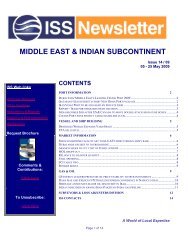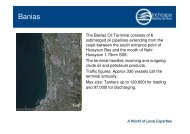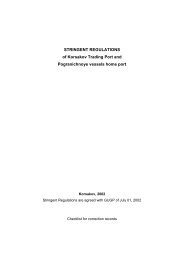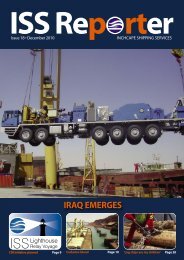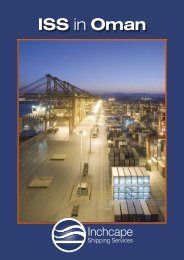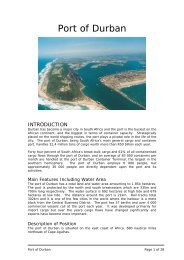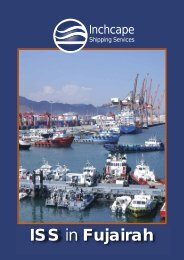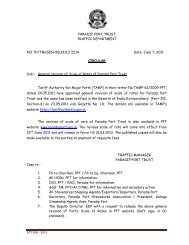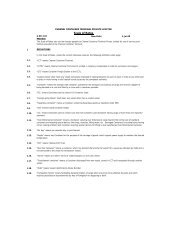Prigorodnoye Export Terminal Port Regulations.pdf - Inchcape ...
Prigorodnoye Export Terminal Port Regulations.pdf - Inchcape ...
Prigorodnoye Export Terminal Port Regulations.pdf - Inchcape ...
Create successful ePaper yourself
Turn your PDF publications into a flip-book with our unique Google optimized e-Paper software.
<strong>Prigorodnoye</strong> <strong>Export</strong> <strong>Terminal</strong> <strong>Port</strong> <strong>Regulations</strong> Rev 01<br />
speed a vessel may proceed in a given thickness of ice. In addition it will determine the distance<br />
the vessel is to be astern of the icebreaker escort, and will also determine the width of navigable<br />
curvature of the channel in turns the ice breaker is to make.<br />
The Ice certificate will also assess vessel suitability for operation in lower temperatures of Aniva<br />
Bay.<br />
7.6 Certificate of Engine Power<br />
All tankers in winter are required to have a ‘Certificate of adequate engine power’ during the ice<br />
season. This confirms that the tanker can achieve a speed of at least 4 knots in ice thickness of<br />
60 cms following in the lead created by ice breakers in the absence of ice pressure. The<br />
certificate is issued by an institute approved by the Russian authorities.<br />
7.7 Propeller Tip Immersion<br />
All tankers are to have a propeller tip immersion of at least 70 cms. LNG carriers are to have<br />
a propeller that is the equivalent of the Russian ice class ‘LU2’. If this is not the case, there<br />
may be a requirement to increase the propeller tip immersion. The required immersion will form<br />
part of the Certificate of adequate engine power.<br />
7.8 Winterisation<br />
Winterisation is the requirement that the vessel, during the winter period, from November<br />
to April, is able to operate in sub zero temperatures down to –25 o C, which may be experienced<br />
within Aniva Bay.<br />
Precautions include measures to ensure that the fire fighting equipment on deck is operational,<br />
in particular that the fire lines do not freeze, that the ballast space air ventilators do not freeze,<br />
and that the mooring equipment is operational. The cargo and ballast systems should be<br />
protected against cold temperatures. The crew are to be provided with appropriate warm<br />
clothing and the accommodation heating must be effective. Other measures will require the<br />
deck steel to be of a grade that will withstand cold temperatures, and internal heating may be<br />
required in the ballast spaces. Steam line dead end sections are to be treated with caution and<br />
drained of condensate which may be susceptible to freezing.<br />
A study of winterisation requirements by SEIC has identified the following requirements.<br />
• Ice class for hull structure - Vessels, which are built with a view to load at <strong>Prigorodnoye</strong><br />
throughout the year, are recommended to be built to the Russian Ice Classification level 'LU2'<br />
or higher. It is a SEIC requirement that all vessels have ice classification for the hull structure.<br />
Although it is possible for a low or no ice class vessel to enter Aniva Bay SEIC does not<br />
recommend this as the safe speeds could be severely limiting.<br />
• Ice classification for propeller and propulsion shafting - Propeller and shafting are to meet the<br />
requirements of the Russian Maritime Register of Shipping’s LU2 ice classification or<br />
equivalent.<br />
• Manifold - The OCIMF "Recommendations for Manifolds for Refrigerated LNGC" and SIGTTO<br />
ship shore compatibility documentation can be used as guides. Recommend that a heated<br />
manifold shelter be fitted on each manifold for use during loading operations. Means to keep<br />
manifold clear of snow and ice to be provided.<br />
• Winterisation - It is to be possible to operate the vessel in sub-zero temperature of -25°C with<br />
0000-S-90-01-P-0207-00-E<br />
Page 22 of 101<br />
BM Code: EP.14.03.01.09



